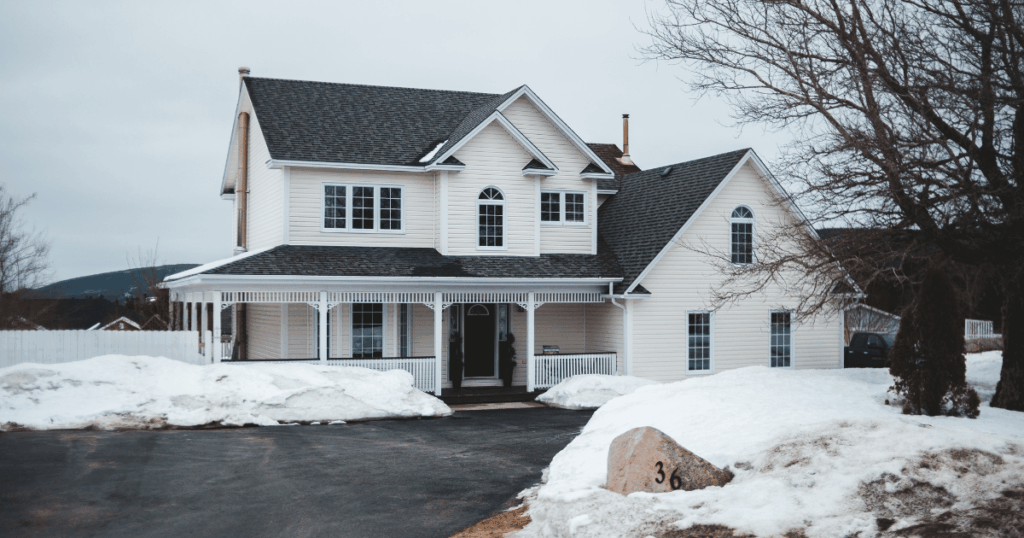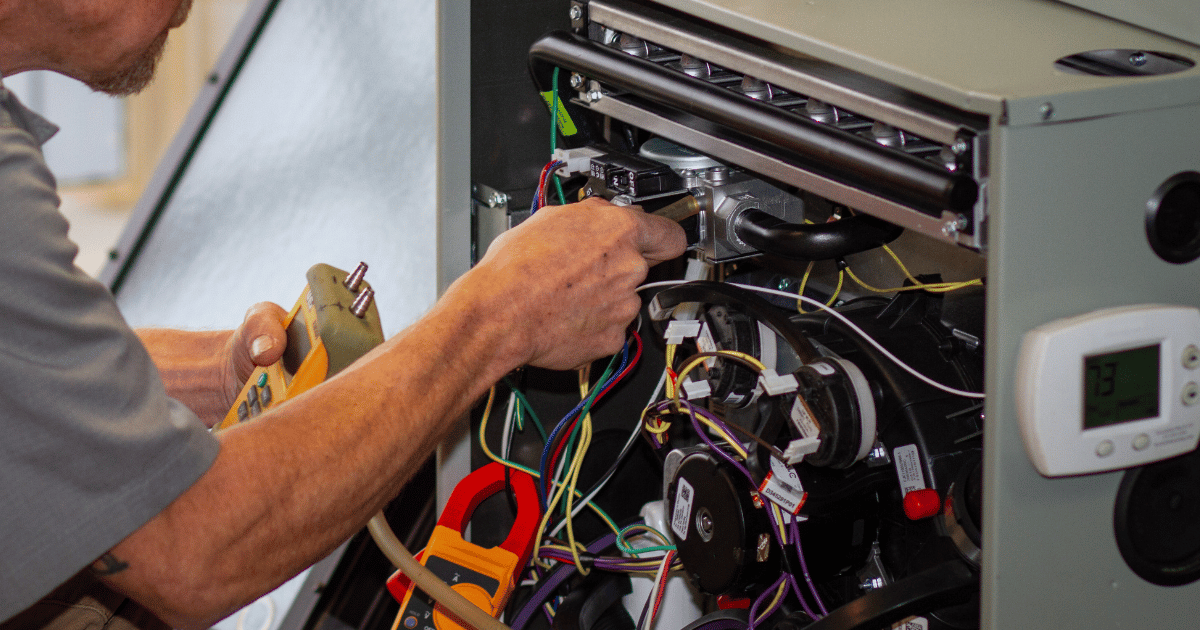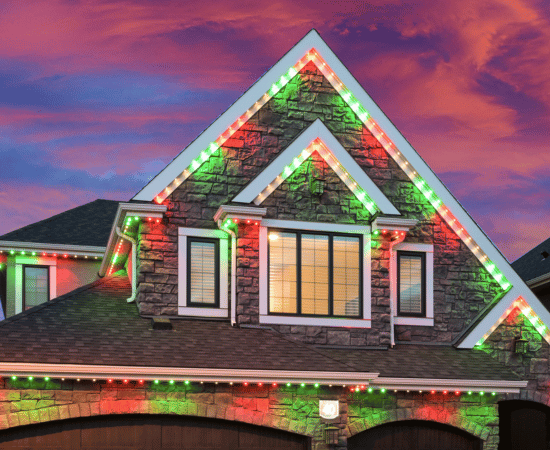Protect your home before the deep freeze hits
Winter home maintenance in Champaign, IL, isn’t just about comfort; it’s about preventing frozen pipes, heat loss, and costly damage when temperatures drop. Central Illinois winters can be unpredictable. One week might feel mild, and the next you’re waking up to frozen pipes and snow-packed gutters. The cold doesn’t just make life uncomfortable; it tests every part of your home’s plumbing, heating, and structure. Getting ahead of the season now can prevent headaches later, and it doesn’t have to be complicated.
Below is a step-by-step guide to keeping your home warm, safe, and efficient this winter.
Winter Home Maintenance Tips for Central Illinois Homes
Start with your roof and gutters
Your roof and gutters take the brunt of snow and ice. Look for missing shingles, loose flashing, or areas where water might pool once the snow melts. Clean out leaves and debris from the gutters so melting snow can drain properly. If you notice sagging or rust spots, it’s worth having a professional take a closer look before the first heavy snow.
Seal up drafts and insulation gaps
Cold air has a way of sneaking in through tiny openings. Run your hand along windows and doors on a windy day. If you feel cold air coming in, you’re also losing heat. Caulk small cracks and replace worn weather-stripping. It’s a small task that makes a big difference in your energy bill and overall comfort. If your attic feels noticeably colder or warmer than the rest of your home, your insulation may need attention, too.
Check your heating system early
The last thing you want is to turn on the furnace and realize it’s not heating evenly or worse, not turning on at all. Schedule a system check before temperatures drop further. A quick tune-up can catch small problems like weak airflow or dirty components before they lead to breakdowns. Replace filters regularly, keep vents clear, and listen for new noises. A furnace that’s running constantly or blowing cool air usually needs attention.
Protect your pipes from freezing
Exposed or poorly insulated pipes are one of the most common winter emergencies. Check pipes in basements, crawl spaces, and garages. If they feel cold to the touch, they’re at risk. Foam sleeves or pipe insulation are inexpensive ways to prevent freezing.
Disconnect hoses and shut off outdoor faucets, then drain the lines completely. If your home has a sprinkler system, have it winterized before the first hard freeze. When temperatures dip well below zero, letting an indoor faucet drip slightly overnight can also relieve pressure and prevent a burst.
Test smoke and carbon monoxide detectors
Heating systems, fireplaces, and space heaters all pose a risk of carbon monoxide buildup. Make sure every detector has working batteries and is within its service life (about 10 years). This is also a good time to review how your fireplace or chimney vents. A quick safety check now is much easier than dealing with a mid-winter emergency.
Keep entryways and walkways safe
Ice and snow make simple routines like walking to the mailbox more dangerous. Stock up on salt or ice melt before storms hit. Check that outdoor lighting works properly so paths are visible after dark. Secure loose railings or steps before they’re hidden under snow.
Prepare for power or heat loss
Storms and outages can happen anywhere, but they’re especially tough in cold weather. Keep an emergency kit with flashlights, blankets, bottled water, and basic supplies in an easy-to-reach spot. If you have pets, plan for them too. It’s not about over-preparing; it’s about staying comfortable and safe while you wait for power or heat to return.
Know When to Call for Help
There’s a line between what’s safe to handle yourself and what could end up costing you more in damage or safety risks. A quick weekend fix can turn into a bigger problem if something gets overlooked, especially in winter when systems are under stress.
When DIY Makes Sense
If it’s a low-risk task, a little time and care go a long way. You can easily:
- Replace furnace filters every 1–3 months
- Caulk small window gaps or reapply weather stripping
- Wrap exposed pipes with foam insulation
- Clear out easy-to-reach gutters on a dry day
- Disconnect outdoor hoses and shut off outdoor faucets
These jobs don’t require specialized tools or training, just attention to detail and a bit of consistency.
When It’s Time to Call a Pro
If something involves gas, wiring, height, or pressurized plumbing, it’s best to call us. A professional has the tools, testing equipment, and safety knowledge to spot issues you can’t see. Here’s where it’s worth bringing us in:
- A furnace that cycles on and off, blows cold air, or smells off
- Roof damage, leaks, or ice dams forming along the gutters
- Frozen or burst pipes, or inconsistent water pressure
- Electrical problems like flickering lights or outlets that stop working
- Drain backups or slow sinks during cold snaps
Sometimes people hesitate to make the call because they assume it’ll be a major repair, but that’s not always the case. Most winter issues start small. Catching them early can mean the difference between a quick visit and a full replacement later.
Our approach is simple: we’ll inspect, explain what’s going on, and only fix what needs fixing. No pushy upsells, just straightforward service to keep your home safe and running smoothly.
Make it easy on yourself
You don’t have to tackle everything in a weekend. Walk around your home, make a short list, and start with the areas that affect comfort and safety the most: heating, plumbing, insulation, and roof drainage. Then, schedule a quick winter maintenance inspection with our team if you’d like a second set of eyes.
A little preparation now means you won’t be scrambling once the first big storm rolls through. Many homeowners wait too long to start their Champaign winter home prep.
Ready to get your home winter-ready?
Our licensed HVAC, plumbing, and electrical teams work throughout Champaign, Urbana, and surrounding Central Illinois communities. If you’d like help checking your systems before the freeze, give us a call. We’ll walk through your home with you and make sure everything’s ready for the cold ahead.
Winter Prep FAQs
What’s the easiest way to tell if my home is losing heat?
Stand near windows and doors on a cold, windy day. If you feel air movement or cold drafts, your seals are leaking. You can also hold a lit candle near baseboards or outlets to see if the flame flickers, an easy sign of air leaks.
How can I keep my pipes from freezing overnight?
Keep your thermostat set at a steady temperature, even when you’re away. Open cabinet doors under sinks on exterior walls to let warm air circulate. In extreme cold, let a faucet drip slightly to relieve pressure and prevent pipe bursts.
Why do my lights flicker when the heater turns on?
That can point to an electrical load issue, outdated wiring, or a loose connection in the breaker panel. It’s not always dangerous, but it’s worth having an electrician inspect it before winter demand peaks.
How often should I replace my furnace filter?
Every one to three months, depending on your system, your pets, and your home’s dust levels. A clogged filter makes your furnace work harder and can lead to uneven heating or higher bills.
Do I really need to shut off outdoor water every winter?
Yes. Even if it’s a frost-proof faucet, water can still sit in the line and expand when frozen. Draining and shutting off the valve from the inside ensures you won’t wake up to a cracked pipe or flooded basement.
How can I tell if my roof needs attention before winter?
Check from the ground for sagging gutters, missing shingles, or dark streaks. Inside, look for water stains on ceilings or walls. If you see any of these, schedule an inspection before snow piles up and hides the damage.
Should I turn off my heat when I travel?
No. Set your thermostat to around 60°F to keep the air circulating and prevent frozen pipes. If you’ll be gone for a week or more, have someone check on your home, especially during cold spells.




